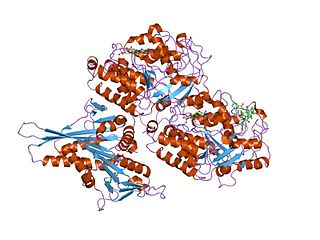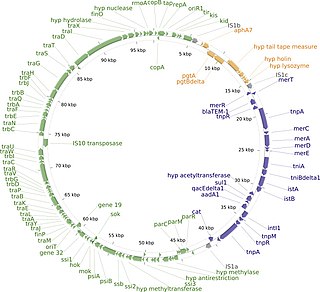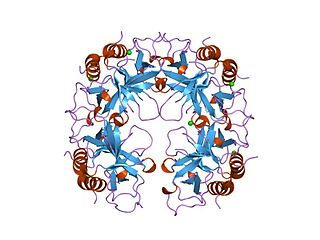Related Research Articles

FtsZ is a protein encoded by the ftsZ gene that assembles into a ring at the future site of bacterial cell division. FtsZ is a prokaryotic homologue of the eukaryotic protein tubulin. The initials FtsZ mean "Filamenting temperature-sensitive mutant Z." The hypothesis was that cell division mutants of E. coli would grow as filaments due to the inability of the daughter cells to separate from one another. FtsZ is found in almost all bacteria, many archaea, all chloroplasts and some mitochondria, where it is essential for cell division. FtsZ assembles the cytoskeletal scaffold of the Z ring that, along with additional proteins, constricts to divide the cell in two.

Tubulin in molecular biology can refer either to the tubulin protein superfamily of globular proteins, or one of the member proteins of that superfamily. α- and β-tubulins polymerize into microtubules, a major component of the eukaryotic cytoskeleton. Microtubules function in many essential cellular processes, including mitosis. Tubulin-binding drugs kill cancerous cells by inhibiting microtubule dynamics, which are required for DNA segregation and therefore cell division.

The nucleoid is an irregularly shaped region within the prokaryotic cell that contains all or most of the genetic material. The chromosome of a typical prokaryote is circular, and its length is very large compared to the cell dimensions, so it needs to be compacted in order to fit. In contrast to the nucleus of a eukaryotic cell, it is not surrounded by a nuclear membrane. Instead, the nucleoid forms by condensation and functional arrangement with the help of chromosomal architectural proteins and RNA molecules as well as DNA supercoiling. The length of a genome widely varies and a cell may contain multiple copies of it.

A tumour inducing (Ti) plasmid is a plasmid found in pathogenic species of Agrobacterium, including A. tumefaciens, A. rhizogenes, A. rubi and A. vitis.

A colicin is a type of bacteriocin produced by and toxic to some strains of Escherichia coli. Colicins are released into the environment to reduce competition from other bacterial strains. Colicins bind to outer membrane receptors, using them to translocate to the cytoplasm or cytoplasmic membrane, where they exert their cytotoxic effect, including depolarisation of the cytoplasmic membrane, DNase activity, RNase activity, or inhibition of murein synthesis.

fis is an E. coli gene encoding the Fis protein. The regulation of this gene is more complex than most other genes in the E. coli genome, as Fis is an important protein which regulates expression of other genes. It is supposed that fis is regulated by H-NS, IHF and CRP. It also regulates its own expression (autoregulation). Fis is one of the most abundant DNA binding proteins in Escherichia coli under nutrient-rich growth conditions.
Segrosomes are protein complexes that ensure accurate segregation (partitioning) of plasmids or chromosomes during bacterial cell division.
In molecular cloning, a vector is any particle used as a vehicle to artificially carry a foreign nucleic sequence – usually DNA – into another cell, where it can be replicated and/or expressed. A vector containing foreign DNA is termed recombinant DNA. The four major types of vectors are plasmids, viral vectors, cosmids, and artificial chromosomes. Of these, the most commonly used vectors are plasmids. Common to all engineered vectors are an origin of replication, a multicloning site, and a selectable marker.

The R1 plasmid is a plasmid that was first isolated from Salmonella paratyphi bacteria in 1963. It is a short plasmid, composed of 97,566 nucleotides and 120 genes, that belongs to the IncFII plasmid group.
ParM is a prokaryotic actin homologue which provides the force to drive copies of the R1 plasmid to opposite ends of rod shaped bacteria before cytokinesis.

A toxin-antitoxin system consists of a "toxin" and a corresponding "antitoxin", usually encoded by closely linked genes. The toxin is usually a protein while the antitoxin can be a protein or an RNA. Toxin-antitoxin systems are widely distributed in prokaryotes, and organisms often have them in multiple copies. When these systems are contained on plasmids – transferable genetic elements – they ensure that only the daughter cells that inherit the plasmid survive after cell division. If the plasmid is absent in a daughter cell, the unstable antitoxin is degraded and the stable toxic protein kills the new cell; this is known as 'post-segregational killing' (PSK).

Nucleotide-binding protein 2 also known as cytosolic Fe-S cluster assembly factor NUBP2 is a protein that in humans is encoded by the NUBP2 gene.

In molecular biology, the ars operon is an operon found in several bacterial taxon. It is required for the detoxification of arsenate, arsenite, and antimonite. This system transports arsenite and antimonite out of the cell. The pump is composed of two polypeptides, the products of the arsA and arsB genes. This two-subunit enzyme produces resistance to arsenite and antimonite. Arsenate, however, must first be reduced to arsenite before it is extruded. A third gene, arsC, expands the substrate specificity to allow for arsenate pumping and resistance. ArsC is an approximately 150-residue arsenate reductase that uses reduced glutathione (GSH) to convert arsenate to arsenite with a redox active cysteine residue in the active site. ArsC forms an active quaternary complex with GSH, arsenate, and glutaredoxin 1 (Grx1). The three ligands must be present simultaneously for reduction to occur.

The CcdA/CcdB Type II Toxin-antitoxin system is one example of the bacterial toxin-antitoxin (TA) systems that encode two proteins, one a potent inhibitor of cell proliferation (toxin) and the other its specific antidote (antitoxin). These systems preferentially guarantee growth of plasmid-carrying daughter cells in a bacterial population by killing newborn bacteria that have not inherited a plasmid copy at cell division.
The parABS system is a broadly conserved molecular mechanism for plasmid partitioning and chromosome segregation in bacteria. Originally identified as a genetic element required for faithful partitioning of low-copy-number plasmids, it consists of three components: the ParA ATPase, the ParB DNA-binding protein, and the cis-acting parS sequence. The parA and parB genes are typically found in the same operon, with parS elements located within or adjacent to this operon. Collectively, these components function to ensure accurate partitioning of plasmids or whole chromosomes between bacterial daughter cells prior to cell division.

The Min System is a mechanism composed of three proteins MinC, MinD, and MinE used by E. coli as a means of properly localizing the septum prior to cell division. Each component participates in generating a dynamic oscillation of FtsZ protein inhibition between the two bacterial poles to precisely specify the mid-zone of the cell, allowing the cell to accurately divide in two. This system is known to function in conjunction with a second negative regulatory system, the nucleoid occlusion system (NO), to ensure proper spatial and temporal regulation of chromosomal segregation and division.
The MinD protein is one of three proteins encoded by the minB operon and also a part of the ParA family of ATPases. It is required to generate pole to pole oscillations prior to bacterial cell division as a means of specifying the midzone of the cell. It is a peripheral membrane ATPase involved in plasmid partitioning.
The MinE protein is one of three proteins of the Min system encoded by the minB operon required to generate pole to pole oscillations prior to bacterial cell division as a means of specifying the midzone of the cell, as seen in E.coli.
The ParMRC system is a mechanism for sorting DNA plasmids to opposite ends of a bacterial cell during cell division. It has three components: ParM, an actin-like protein that forms a long filament to push two plasmids apart, ParR, which binds the plasmid to ParM and generates the ParM filament, and parC, which is a DNA sequence on the plasmid that anchors ParR to itself.
The locus of enterocyte effacement-encoded regulator (Ler) is a regulatory protein that controls bacterial pathogenicity of enteropathogenic Escherichia coli (EPEC) and enterohemorrhagic Escherichia coli (EHEC). More specifically, Ler regulates the locus of enterocyte effacement (LEE) pathogenicity island genes, which are responsible for creating intestinal attachment and effacing lesions and subsequent diarrhea: LEE1, LEE2, and LEE3. LEE1, 2, and 3 carry the information necessary for a type III secretion system. The transcript encoding the Ler protein is the open reading frame 1 on the LEE1 operon.
References
- 1 2 3 Dmowski M, Jagura-Burdzy G (2013). "Active stable maintenance functions in low copy-number plasmids of Gram-positive bacteria I. Partition systems" (PDF). Polish Journal of Microbiology / Polskie Towarzystwo Mikrobiologów = the Polish Society of Microbiologists. 62 (1): 3–16. PMID 23829072.
- ↑ Friedman SA, Austin SJ (1988). "The P1 plasmid-partition system synthesizes two essential proteins from an auto-regulated operon". Plasmid. 19 (2): 103–12. doi:10.1016/0147-619X(88)90049-2. PMID 3420178.
- 1 2 Gerdes K, Møller-Jensen J, Bugge Jensen R (2000). "Plasmid and chromosome partitioning: surprises from phylogeny". Molecular Microbiology. 37 (3): 455–66. doi: 10.1046/j.1365-2958.2000.01975.x . PMID 10931339.
- ↑ Bouet, Jean-Yves; Funnell, Barbara E. (2019-06-19). "Plasmid Localization and Partition in Enterobacteriaceae". EcoSal Plus. 8 (2). doi: 10.1128/ecosalplus.ESP-0003-2019 . ISSN 2324-6200. PMID 31187729.
- ↑ Ah-Seng, Y; Lane, D; Pasta, F; Lane, D; Bouet, JY (2009). "Dual role of DNA in regulating ATP hydrolysis by the SopA partition protein". Journal of Biological Chemistry. 70 (44): 30067–75. doi: 10.1074/jbc.M109.044800 . PMC 2781561 . PMID 19740757.
- 1 2 3 4 5 Schumacher MA (2012). "Bacterial plasmid partition machinery: a minimalist approach to survival". Current Opinion in Structural Biology. 22 (1): 72–9. doi:10.1016/j.sbi.2011.11.001. PMC 4824291 . PMID 22153351.
- 1 2 3 Chen Y, Erickson HP (2008). "In vitro assembly studies of FtsZ/tubulin-like proteins (TubZ) from Bacillus plasmids: evidence for a capping mechanism". The Journal of Biological Chemistry. 283 (13): 8102–9. doi: 10.1074/jbc.M709163200 . PMC 2276378 . PMID 18198178.
- ↑ Badrinarayanan, Anjana; Le, Tung B. K.; Laub, Michael T. (2015-11-13). "Bacterial Chromosome Organization and Segregation". Annual Review of Cell and Developmental Biology. 31: 171–199. doi:10.1146/annurev-cellbio-100814-125211. ISSN 1530-8995. PMC 4706359 . PMID 26566111.
- ↑ Bouet, JY; Ah-Seng, Y; Benmeradi, N; Lane, D (2007). "Polymerization of SopA partition ATPase: regulation by DNA binding and SopB". Molecular Microbiology. 63 (2): 468–81. doi: 10.1111/j.1365-2958.2006.05537.x . PMID 17166176.
- ↑ Castaing, JP; Bouet, JY; Lane, D (2008). "F plasmid partition depends on interaction of SopA with non-specific DNA". Molecular Microbiology. 70 (4): 1000–11. doi: 10.1111/j.1365-2958.2008.06465.x . PMID 18826408. S2CID 26612131.
- ↑ Hwang, Ling Chin; Vecchiarelli, Anthony G.; Han, Yong-Woon; Mizuuchi, Michiyo; Harada, Yoshie; Funnell, Barbara E.; Mizuuchi, Kiyoshi (2013-05-02). "ParA-mediated plasmid partition driven by protein pattern self-organization". The EMBO Journal. 32 (9): 1238–1249. doi:10.1038/emboj.2013.34. ISSN 1460-2075. PMC 3642677 . PMID 23443047.
- ↑ Vecchiarelli, Anthony G.; Hwang, Ling Chin; Mizuuchi, Kiyoshi (2013-04-09). "Cell-free study of F plasmid partition provides evidence for cargo transport by a diffusion-ratchet mechanism". Proceedings of the National Academy of Sciences of the United States of America. 110 (15): E1390–1397. Bibcode:2013PNAS..110E1390V. doi: 10.1073/pnas.1302745110 . ISSN 1091-6490. PMC 3625265 . PMID 23479605.
- ↑ Bouet, JY; Funnell, BE (1999). "P1 ParA interacts with the P1 partition complex at parS and an ATP-ADP switch controls ParA activities". EMBO J. 18 (5): 1415–24. doi:10.1093/emboj/18.5.1415. PMC 1171231 . PMID 10064607.
- ↑ Vecchiarelli, Anthony G.; Neuman, Keir C.; Mizuuchi, Kiyoshi (2014-04-01). "A propagating ATPase gradient drives transport of surface-confined cellular cargo". Proceedings of the National Academy of Sciences of the United States of America. 111 (13): 4880–4885. Bibcode:2014PNAS..111.4880V. doi: 10.1073/pnas.1401025111 . ISSN 1091-6490. PMC 3977271 . PMID 24567408.
- ↑ Vecchiarelli, Anthony G.; Han, Yong-Woon; Tan, Xin; Mizuuchi, Michiyo; Ghirlando, Rodolfo; Biertümpfel, Christian; Funnell, Barbara E.; Mizuuchi, Kiyoshi (2010-08-18). "ATP control of dynamic P1 ParA-DNA interactions: a key role for the nucleoid in plasmid partition". Molecular Microbiology. 78 (1): 78–91. doi:10.1111/j.1365-2958.2010.07314.x. ISSN 0950-382X. PMC 2950902 . PMID 20659294.
- ↑ Hu, Longhua; Vecchiarelli, Anthony G.; Mizuuchi, Kiyoshi; Neuman, Keir C.; Liu, Jian (2015-12-08). "Directed and persistent movement arises from mechanochemistry of the ParA/ParB system". Proceedings of the National Academy of Sciences of the United States of America. 112 (51): E7055–64. Bibcode:2015PNAS..112E7055H. doi: 10.1073/pnas.1505147112 . ISSN 1091-6490. PMC 4697391 . PMID 26647183.
- ↑ Vecchiarelli, Anthony G.; Seol, Yeonee; Neuman, Keir C.; Mizuuchi, Kiyoshi (2014-01-01). "A moving ParA gradient on the nucleoid directs subcellular cargo transport via a chemophoresis force". Bioarchitecture. 4 (4–5): 154–159. doi:10.4161/19490992.2014.987581. ISSN 1949-100X. PMC 4914017 . PMID 25759913.
- ↑ Ietswaart, Robert; Szardenings, Florian; Gerdes, Kenn; Howard, Martin (2014-12-01). "Competing ParA structures space bacterial plasmids equally over the nucleoid". PLOS Computational Biology. 10 (12): e1004009. Bibcode:2014PLSCB..10E4009I. doi: 10.1371/journal.pcbi.1004009 . ISSN 1553-7358. PMC 4270457 . PMID 25521716.
- ↑ Walter, JC; Dorignac, J; Lorman, V; Rech, J; Bouet, JY; Nollmann, M; Palmeri, J; Parmeggiani, A; Geniet, F (2017). "Surfing on protein waves: proteophoresis as a mechanism for bacterial genome partitioning". Physical Review Letters. 119 (28101): 028101. arXiv: 1702.07372 . Bibcode:2017PhRvL.119b8101W. doi:10.1103/PhysRevLett.119.028101. PMID 28753349. S2CID 6762277.
- ↑ Sanchez, Aurore; Rech, Jérôme; Gasc, Cyrielle; Bouet, Jean-Yves (March 2013). "Insight into centromere-binding properties of ParB proteins: a secondary binding motif is essential for bacterial genome maintenance". Nucleic Acids Research. 41 (5): 3094–3103. doi:10.1093/nar/gkt018. ISSN 1362-4962. PMC 3597684 . PMID 23345617.
- ↑ Surtees, Jennifer A.; Funnell, Barbara E. (1999). "P1 ParB Domain Structure Includes Two Independent Multimerization Domains". Journal of Bacteriology. 181 (19): 5898–5908. doi: 10.1128/jb.181.19.5898-5908.1999 . ISSN 1098-5530. PMC 103615 . PMID 10498700.
- ↑ Gunning PW, Ghoshdastider U, Whitaker S, Popp D, Robinson RC (2015). "The evolution of compositionally and functionally distinct actin filaments". J Cell Sci. 128 (11): 2009–19. doi: 10.1242/jcs.165563 . PMID 25788699.
- ↑ Møller-Jensen J, Borch J, Dam M, Jensen RB, Roepstorff P, Gerdes K (2003). "Bacterial mitosis: ParM of plasmid R1 moves plasmid DNA by an actin-like insertional polymerization mechanism". Molecular Cell. 12 (6): 1477–87. doi: 10.1016/S1097-2765(03)00451-9 . PMID 14690601.
- ↑ Ni L, Xu W, Kumaraswami M, Schumacher MA (2010). "Plasmid protein TubR uses a distinct mode of HTH-DNA binding and recruits the prokaryotic tubulin homolog TubZ to effect DNA partition". Proceedings of the National Academy of Sciences of the United States of America. 107 (26): 11763–8. doi: 10.1073/pnas.1003817107 . PMC 2900659 . PMID 20534443.
- ↑ Guynet C, Cuevas A, Moncalián G, de la Cruz F (2011). "The stb operon balances the requirements for vegetative stability and conjugative transfer of plasmid R388". PLOS Genetics. 7 (5): e1002073. doi: 10.1371/journal.pgen.1002073 . PMC 3098194 . PMID 21625564.
- 1 2 Guynet C, de la Cruz F (2011). "Plasmid segregation without partition". Mobile Genetic Elements. 1 (3): 236–241. doi:10.4161/mge.1.3.18229. PMC 3271553 . PMID 22312593.